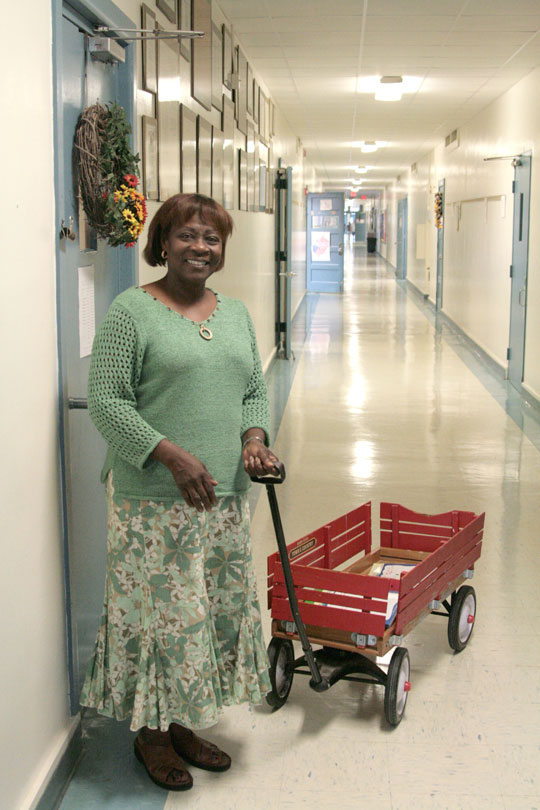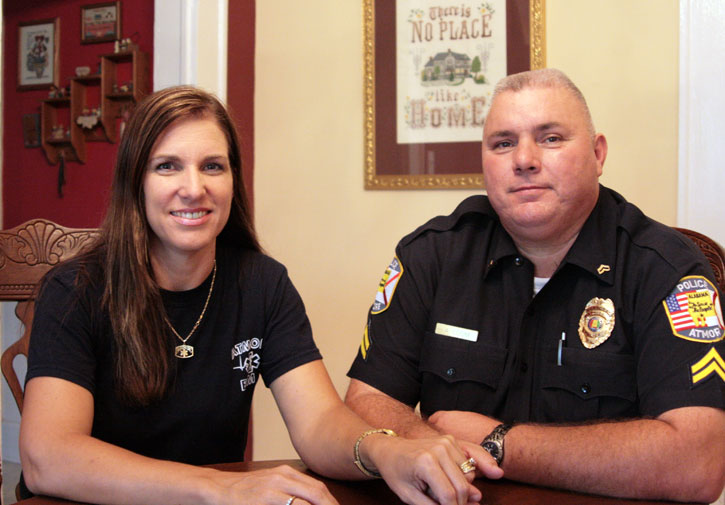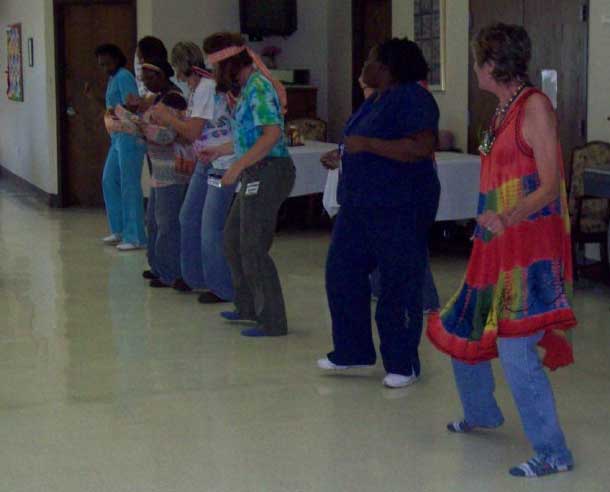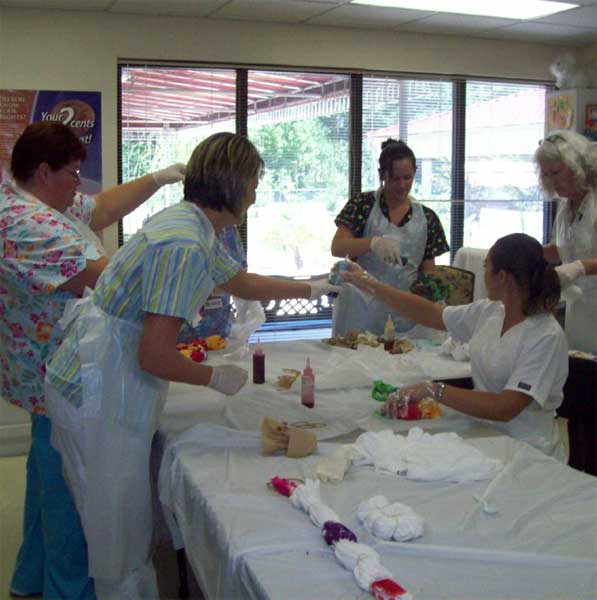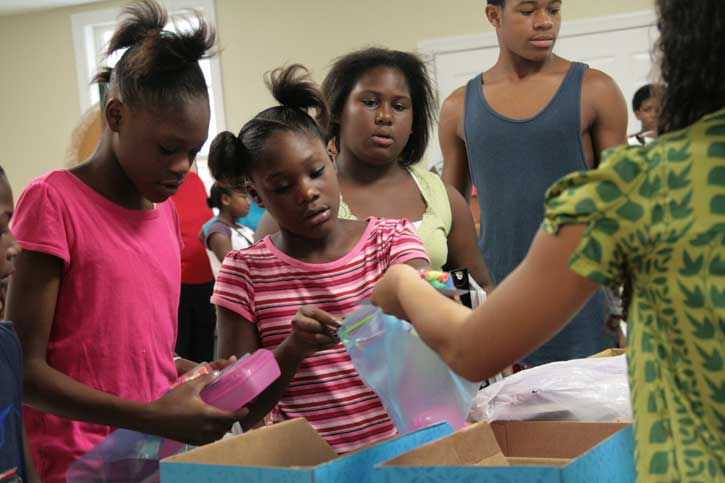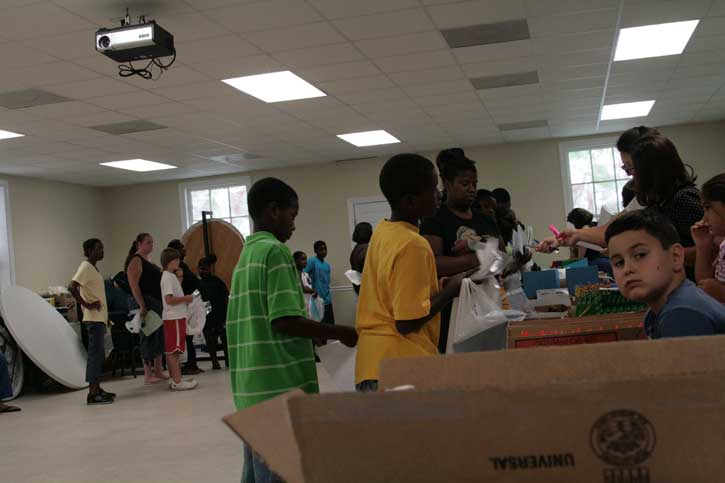Becoming One: Teacher Liaison Working To Bring Communities Together
August 24, 2009
The transition of Carver/Century K-8 School into Ernest Ward Middle and Bratt Elementary will go smoothly. Just ask anyone involved with either school in any capacity, and they are sure of it.
Except for Joyce Wright-Evans. She’s double sure.
Wright-Evans is a teacher on special assignment as a community liaison at Bratt and Ernest Ward this year in a position funded by federal stimulus dollars to help ensure that parents and the community are as involved as possible with the two schools. It is all part of the plan to make sure the consolidation of Carver/Century K-8 into Ernest Ward and Bratt goes as smoothly as possible.
“It’s going to be a great year,” Wright-Evans said last week while sitting in the office of Ernest Ward Principal Nancy Gindl-Perry. “I am very proud to be part of the Ernest Ward family.”
“You hear that?” Perry asked. “Part of the Ernest Ward family…that’s what we are here at Ernest Ward…family.”
With hundreds of children in the two schools — an expected 547 just at Ernest Ward — a big part of Wright-Evans’ job will be helping parents and the community feel like part of that family at EWMS and Bratt Elementary.
 “I think she has the right temperament, and she has the right personality. She’s very energetic, and that passion for children is going to show,” Escambia School Superintendent Malcolm Thomas said of Wright-Evans. “She is going to be a good thing for everyone involved with either school.”
“I think she has the right temperament, and she has the right personality. She’s very energetic, and that passion for children is going to show,” Escambia School Superintendent Malcolm Thomas said of Wright-Evans. “She is going to be a good thing for everyone involved with either school.”
Jeff Garthwaite, former principal of Carver/Century K-8 School and now stimulus funds coordinator for the school district, agreed.
“She will be there to help plan community activities like open house, and she will be there to smooth out any bumps in the road that might happen,” Garthwaite said. “She will troubleshoot any problems, and she will act as an advocate for children and parents with the school.”
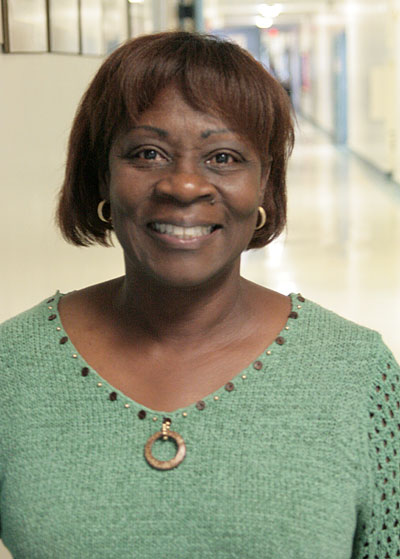 “Parents can contact me about anything involving the schools,” she said. “We work together as a team.”
“Parents can contact me about anything involving the schools,” she said. “We work together as a team.”
Wright-Evans will also be reaching out to community groups and businesses, looking for their involvement with Bratt and Ernest Ward.
“It’s all about the kids,” Wright-Evans said. “It is about each one of them. The kids come first.”
Wright-Evans will maintain an office at Ernest Ward and travel frequently to Bratt. To contact her about any issue or more information on how to become involved with the two schools, email jwright-evans@escambia.k12.fl.us or call Ernest Ward Middle at 327-4283 or Bratt Elementary at 327-6137.
Pictured: Joyce Wright-Evans in the hallway at Ernest Ward Middle School. NorthEscambia.com photos, click to enlarge.
Police Officer Husband Saves Choking Paramedic Wife; She Taught Him How
August 21, 2009
When Atmore paramedic Susan Odom taught a CPR and Heimlich Maneuver class to a group of Atmore Police officers, she never imagined that the training would save her life. And she certainly never thought her husband would be the one to come to her rescue.
Susan had finished her shift at Atmore Ambulance and headed to her Atmore home last Friday morning. Her husband, Atmore Police Department Corporal Arthur Odom, was at work, filling out a report at the police station.
That’s when the first 911 call for help came in. Dispatcher Betty Cox took the call from the Odom home, but there was seemingly no one on the line.
“The kids were off to school, and I was just doing the normal stuff — cleaning house,” Susan said. “I had some watermelon and a banana. I swallowed and knew something was wrong. It was stuck in my throat; it would not come up. I knew I started panicking.”
As a certified instructor, Susan knew about the Heimlich Maneuver, a series abdominal thrusts used to dislodge an item lodged in the airway. She even knew how to perform the Heimlich on herself, leaning at first over a dining room table chair, and then over a high sink in the bathroom. But nothing worked.
Betty Cox, the dispatcher, asked Arthur if there would be anyone at his house that would be playing on the phone making calls to 911. She knew where the silent call was originating from thanks to the computerized E911 system.
Arthur left the police station and began driving the mile to his house. That’s when the dispatcher notified him that there had been a second 911 call from his house.
“The phone had dropped the call,” Susan said. “So I called back. All I could do was hit the floor to make noise. I did not know what else to do. I realized I was in real trouble. I don’t really remember what happened next; I was real close to blacking out. The next thing I knew, my husband was coming in.”
“When that second call came in, I knew something was not right,” he said. “I found her in the floor when I came in the house.”
“That’s when all of that training kicked in,” Arthur said. Susan had trained him well. He performed the Heimlich Maneuver, eventually clearing her airway, saving her life.
After the obstruction was cleared, paramedic Susan refused to let her coworkers from Atmore Ambulance take her to the hospital.
Instead, she and Arthur did something that she admits some might find unusual moments after being saved from death by choking.
They went to eat lunch.
“I did eat very carefully,” she said.
“It’s what we both do,” she said. “We help people everyday. It was routine, part of our training. Sure, it happened to us, but it did not bother either one of us too much.”
“He did save my life, and I am very thankful for him every day,” she said. “He is my hero.”
Call it a perfect match, he says. The proverbial two peas in a pod.
“We actually met at a motorcycle wreck,” he said. He was there working as a police officer; she was there as the paramedic on the Atmore Ambulance that responded. They have been married for four and half years now.
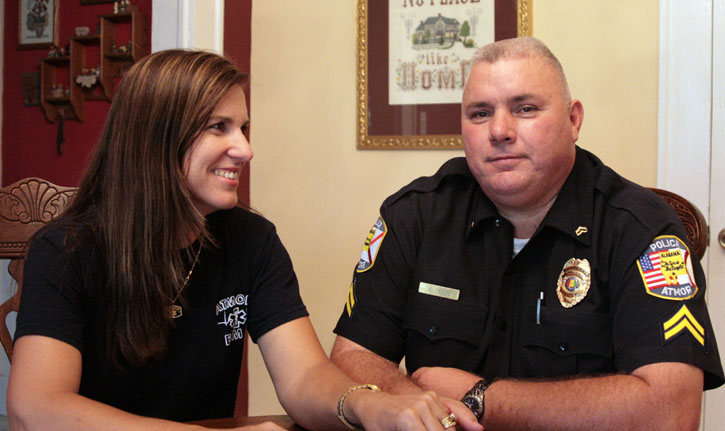 “It was love at first sight,” Arthur said, cracking a little smile. “I saw her, and that was it.”
“It was love at first sight,” Arthur said, cracking a little smile. “I saw her, and that was it.”
He never knew that when he swept her off her feet, he would be saving her life.
“I have confidence in all the officers,” she said, noting that they had all taken her class and been recertified in CPR and the Heimlich Maneuver.
“Last week, Atmore Police Officer Arthur Odom responded to a strange 911 call at his own house,” Channel 3 News anchor Bob Solarski began a report on WEAR Thursday night as Arthur and Susan gathered around the TV to watch.
“I don’t like how they did the report,” she said as the report aired. “It was not really them; it just does not seem right to see us sitting there on the TV talking about this.”
But she hopes the attention from the WEAR interview, an interview on WKRG TV and this NorthEscambia.com article accomplished one thing — “I hope this gets more people to sign up for a CPR class that includes the Heimlich Maneuver. I’m living proof that it can save someone.”
Part of the American Heart Association class that Susan teaches also stresses the importance of using a landline –not a cellular — phone to call 911 when possible.
“If I had called from a cell phone, they would not have known where to send help,” Susan said. “Even though I could not speak, they knew were to send help because our address showed up on the E911 system.”
Pictured above: Susan and Arthur Odom at their Atmore home. NorthEscambia.com photos, click to enlarge.
Hundreds Get To Know Ernest Ward
August 21, 2009
Pictured: Hundreds of parents and students attended the sixth grade and new student orientation Thursday morning at Ernest Ward Middle School. With growth — partially from the closure and consolidation of Carver/Century K-8 School — Ernest Ward has an expected record enrollment this year of 547 students. At the top, Ernest Ward Band Director Charles Tucker explains his band program to parents and students Thursday morning. Pictured left: Hundreds pack the hallways of the school during a tour. NorthEscambia.com photos, click to enlarge.
Teachers Returned Monday; Plus: A Look Inside New Modular Buildings
August 17, 2009
Teachers in the Escambia County School District returned to work Monday.
Ten new classrooms have been installed this year in modular buildings at Ernest Ward Middle and Bratt Elementary schools. The two buildings, which totaled just over $1 million, provide extra space after the closure of Carver/Century K-8 School.
Five classrooms with included restrooms, five sinks and two closets were installed at Bratt Elementary. The improvements at Ernest Ward Middle included five classrooms, two closets, and one 24 by 36 foot restroom facility.
The modular buildings are hurricane rated, and they are connected to the main buildings at the schools with covered sidewalks.
Escambia School Superintendent Malcolm Thomas said the modular buildings are not the “portables” that many adults remember from their days in school. Rather, he said, they are high quality near permanent type construction.
Pictured top: New modular buildings installed at Ernest Ward Middle School. Pictured in three photos below: A look inside the new classrooms. NorthEscambia.com photos, click to enlarge.
Northview FFA Holds Officer Leadership Retreat
August 17, 2009
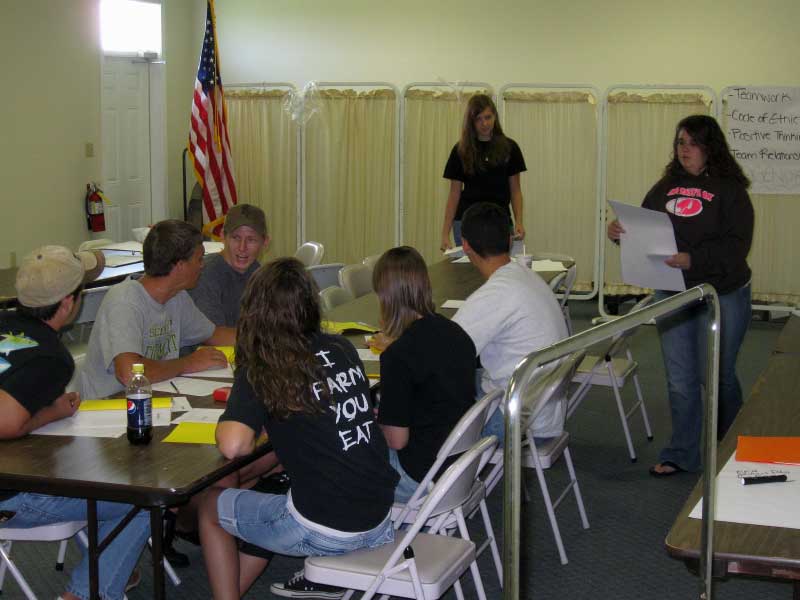
The Northview Chapter of the National FFA Organization recently held a student leadership retreat.
The chapter officers meet for a day long event to prepare for the upcoming school year. Officers participated in workshops at the Walnut Hill Community Center dealing with teamwork, communications and personal development as related to professional presentation in the workforce.
The 2009-10 chapter officers attending were Micah Byars, Lydia Weaver, Stephanie Solari, Allie Vidak, Heather Kite, Gavin Hinote, Wes Chancery and Devin Bell. Lance Blackburn and Lisa Bardin spoke to the officers concerning expectations in the workforce.
Click here for a photo gallery.
Pictured above: Northview FFA officers recently participated in a leadership retreat. Submitted photo for NorthEscambia.com, click to enlarge.
Not Just For Books: A World Of Services Awaits At The Library
August 16, 2009
Jillian Thorton of Bluff Springs was happy on a recent afternoon, reading a good book by a window in the Century Branch Library. Meanwhile, sister Jenna Thornton and her friend Leah Fischer were on the computer, and brother Chance Thornton was busy searching the shelves for a good book. It was a break from a hot summer afternoon.
The Thorntons are not alone; the Century Branch Library has seen a surge in traffic the past few months, with over 2,000 individuals using the library in July.
The library offers many free items and services beyond just books that people find useful, especially in the down economy, Librarian Patricia Rigel said.
“Like our movies,” she said. “We have hundreds of movies, including the latest releases.” The library’s movie collection is divided into two sections — one for children and one for adults.
The Century Branch Library has computers in the children’s area, and computers with Internet access in another room.
“More and more people are using the computers,” Rigel said. “With the bad economy, more people are using the computers to look for a job.” She said 400 people used the library computers during July.
 “Libraries do better when the economy is down,” she said. “People find that they library offers so many things that are free.”
“Libraries do better when the economy is down,” she said. “People find that they library offers so many things that are free.”
From reading a favorite book without paying $30 at the bookstore, to the movies for checkout, to the free internet, a chance to read magazines for free, books on tape/CD and more — people are discovering that the library offers a lot of free entertainment and education, Rigel said. The library also offers free wi-fi for persons wishing to use the Internet on their own laptops.
“I like the books on CD,” Rigel said. “When you are driving you can just pop one of those in the car CD player and enjoy your favorite book.”
The library also a meeting room available for use by non-profit groups and organizations.
The Century Branch Library will soon be offering several free beginning level computer courses, including mouse skills on September 9, typing on September 16, keyboarding on September 23, and an introduction to Windows on September 30.
During the month of July, 2,039 people used the Century Branch Library. The library issued 51 new library cards in July.
The Century Branch Library is open Tuesday, Wednesday, Friday and Saturday from 9 a.m. to 5 p.m.. On Thursday, the library is open from noon until 8 p.m. The Century Branch Library is located at 7991 North Century Boulevard. For more information on the library or any of its services, call (850) 256-6218.
Pictured top: Friends Jenna Thornton and Leah Fischer use the computers at the Century Branch Library. Pictured inset: Jillian Thorton reads a book while Chance Thornton searches for the perfect book at the library. Pictured bottom: The Century Branch Library’s DVD’s available for checkout span the top shelf of a bookcase. NorthEscambia.com photos, click to enlarge.
Peace Dude! Happy Hippie Day!
August 15, 2009
 Today marks the 40th anniversary of the first day of Woodstock music festival. The residents of Century Care Center celebrated on Friday with Hippie Day — compete with tie dye t-shirts and lots of lighthearted fun.
Today marks the 40th anniversary of the first day of Woodstock music festival. The residents of Century Care Center celebrated on Friday with Hippie Day — compete with tie dye t-shirts and lots of lighthearted fun.
Pictured above and below: Hippie Day at Century Care Center. Pictured inset: Longtime Century Care Center resident Myrtle Bray. Submitted photos for NorthEscambia.com, click to enlarge.
Lending A Helping Hand: Church Provides Free School Supplies
August 15, 2009
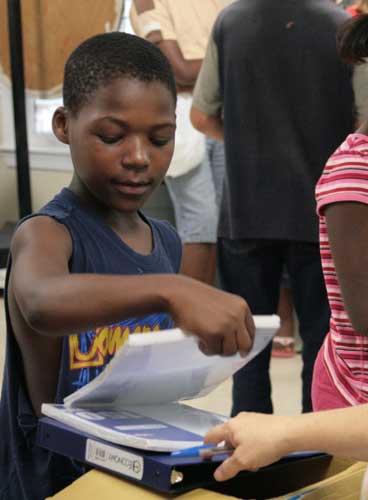 A Century church provided free school supplies to scores of children Friday morning.
A Century church provided free school supplies to scores of children Friday morning.
Dozens of children at time lined up at Abundant Life Assembly of God with their school supplies lists to receive the items they need for school.
School starts Monday, August 24 in Escambia and Santa Rosa counties.
Pictured: Free school supplies were handed out Friday at Abundant Life Assembly of God in Century. NorthEscambia.com photos, click to enlarge.
Green Named New Coordinator For Learn To Read Of Century
August 13, 2009
Patsy Green of Bluff Springs has been hired as the new volunteer coordinator for Learn to Read of Century.
Green, a retired educator, has served as a volunteer for the past few years at Learn To Read, teaching adults reading skills.
“It’s a very good program,” she said. “We are all aware that some folks come through school and can’t read. I’m so happy that this program gives people the opportunity to learn to read.”
Learn to Read of Northwest Florida is a non-profit adult literacy program in Escambia and Santa Rosa counties that provides free one-on-one tutoring in basic reading and writing, GED preparation and English as a second language.
As a Learn to Read volunteer, Green has spent the past couple of years teaching a man in his early 30’s to read. Green said he is now getting a job after improving his reading skills.
“Reading was a big confidence boost that contributed to him getting the job,” she said.
She takes pride in another of her student’s accomplishments.
“Learning to read allows him to read his Bible,” she said. “He was excited that he was able to read two pages of his Bible Monday night at his Bible study.”
Green is a native of the Century area. She was, in fact, born in the former hospital building that now houses Learn to Read of Century. She is graduate of Century High School, Pensacola Junior College and the University of Florida. She taught at Century Middle School, Century Elementary and Carver/Century K-8 School for a total of 30 years, interrupted only by a one year leave to attend Auburn University for a M.Ed. in specific learning disabilities and a five year period to be home with her sons.
After her retirement from Carver/Century, she has, in addition to tutoring for Learn to Read, privately tutored a math student; substituted at Carver/Century, Byrneville Elementary and Westgate School; volunteered at Carver/Century; and served as leader of TOPS #125 of McDavid.
Patsy Green and her husband David reside in Bluff Springs. Sons Marcus and John now live and work in Pensacola. She is a member of Grace Baptist Church in McDavid where she serves as youth leader, serves as assistant youth director for the Baptist Missionary Association of Northwest Florida and is coordinator of the L.J. Stewart Baptist Camp.
For more information on Learn to Read of Century, call (850) 256-0880.
Jay Hospital Foundation Awards Scholarships
August 13, 2009
The Jay Hospital Employee Foundation has awarded three college-bound students with $1,000 scholarships to help with their school expenses.
The 2009 recipients are Christi McNaughton, Jay High School; Tia Shallow, Pace High School; and Adam Fuqua, W.S. Neal High School.
The foundation offers scholarships each year to students in high schools located in the Jay Hospital service area including Jay, Northview, Flomaton, Central, W.S. Neal, Flomaton, Century, Milton and Pace.
Grades, class rank, ACT scores and volunteer hours are considered in the selection process. To ensure fairness, students’ names are not included on the selection roster.
The Jay Hospital Employee Foundation also provides assistance to employees in need, contributes to disaster recovery and supports local charitable organizations including the American Cancer Society.
Pictured: Jay Hospital Employee Foundation scholarship winners Christi McNaughton, Jay High School; Adam Fuqua, W.S. Neal High School; and Tia Shallow, Pace High School. Submitted photo for NorthEscambia.com, click to enlarge.


